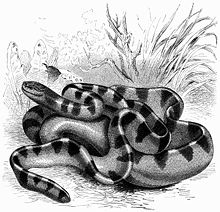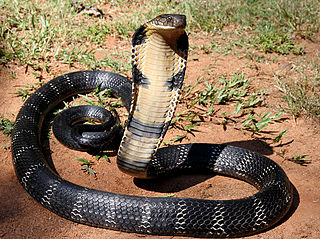
Elapidae is a family of snakes characterized by their permanently erect fangs at the front of the mouth. Most elapids are venomous, with the exception of the genus Emydocephalus. Many members of this family exhibit a threat display of rearing upwards while spreading out a neck flap. Elapids are endemic to tropical and subtropical regions around the world, with terrestrial forms in Asia, Australia, Africa, and the Americas and marine forms in the Pacific and Indian Oceans. Members of the family have a wide range of sizes, from the 18 cm (7.1 in) white-lipped snake to the 5.85 m king cobra. Most species have neurotoxic venom that is channeled by their hollow fangs, and some may contain other toxic components in various proportions. The family includes 55 genera with some 360 species and over 170 subspecies.

Antimicrobial peptides (AMPs), also called host defence peptides (HDPs) are part of the innate immune response found among all classes of life. Fundamental differences exist between prokaryotic and eukaryotic cells that may represent targets for antimicrobial peptides. These peptides are potent, broad spectrum antimicrobials which demonstrate potential as novel therapeutic agents. Antimicrobial peptides have been demonstrated to kill Gram negative and Gram positive bacteria, enveloped viruses, fungi and even transformed or cancerous cells. Unlike the majority of conventional antibiotics it appears that antimicrobial peptides frequently destabilize biological membranes, can form transmembrane channels, and may also have the ability to enhance immunity by functioning as immunomodulators.

Stokes's sea snake is a large species of sea snake in the family Elapidae. It is sometimes placed in its own genus Astrotia. The species is endemic to tropical Indo-Pacific oceanic waters.
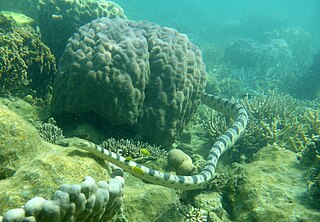
The olive-headed sea snake, also known as the greater sea snake, is a species of venomous sea snake in the family Elapidae.

Hydrophis schistosus, commonly known as the beaked sea snake, hook-nosed sea snake, common sea snake, or the Valakadeyan sea snake, is a highly venomous species of sea snake common throughout the tropical Indo-Pacific. This species is implicated in more than 50% of all bites caused by sea snakes, as well as the majority of envenomings and fatalities.

Hydrophis belcheri, commonly known as the faint-banded sea snake or Belcher's sea snake, is an extremely venomous species of elapid sea snake. It has a timid temperament and would normally have to be subjected to severe mistreatment before biting. Usually those bitten are fishermen handling nets, although only one-quarter of those bitten are envenomated since the snake rarely injects much of its venom. Although not much is known about the venom of this species, its LD50 toxicity in mice has been determined to be 0.24 mg/kg when delivered intramuscularly.

Hydrophis caerulescens, commonly known as the dwarf sea snake, is a species of venomous sea snake in the family Elapidae.
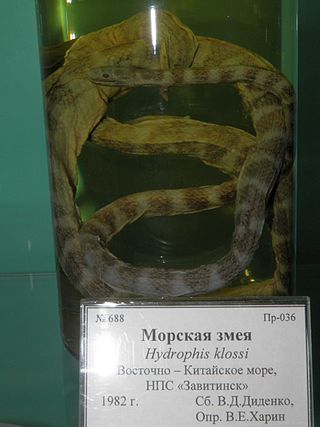
Hydrophis klossi, commonly known as Kloss's sea snake, is a species of sea snake in the family Elapidae. Like all other sea snakes, it is venomous. The species is endemic to the Indian Ocean.
Hydrophis lapemoides is a species of snake in the family Elapidae known commonly as the Persian Gulf sea snake. This sea snake is native to the Indian Ocean from the Persian Gulf to the coasts of Thailand.

Hydrophis melanocephalus, commonly known as the slender-necked sea snake, is a species of venomous sea snake in the family Elapidae.
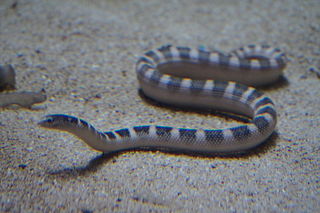
Hydrophis ornatus, commonly known as the ornate reef sea snake, is a species of venomous sea snake in the family Elapidae.
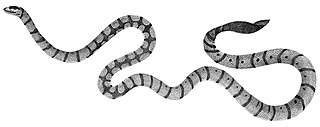
Hydrophis spiralis, commonly known as the yellow sea snake, is a species of venomous sea snake in the family Elapidae.
Hydrophis stricticollis, commonly called the collared sea snake, is a species of venomous sea snake in the family Elapidae.

Jerdon's sea snake is a species of venomous sea snake in the subfamily Hydrophiinae.

The spine-bellied sea snake, also commonly known as Hardwicke's sea snake and Hardwicke's spine-bellied sea snake, is a species of venomous sea snake in the family Elapidae.
Hydrophis cantoris, also known commonly as Cantor's narrow-headed sea snake and Cantor's small-headed sea snake, is a species of venomous sea snake in the family Elapidae.
Hydrophis viperinus, commonly known as the viperine sea snake, is a species of venomous sea snake in the family Elapidae (Hydrophiinae).

Cathelicidin antimicrobial peptide (CAMP) is a polypeptide that is primarily stored in the lysosomes of macrophages and polymorphonuclear leukocytes (PMNs); in humans, the CAMP gene encodes the peptide precursor CAP-18, which is processed by proteinase 3-mediated extracellular cleavage into the active form LL-37. LL-37 is the only peptide in the Cathelicidin family found in the human body.
Pseudin is a peptide derived from Pseudis paradoxa. Pseudins have some antimicrobial function.

Naja christyi, commonly known as the Congo water cobra or Christy's water cobra, is a species of venomous snakes belonging to the family Elapidae. The species is native to Sub-Saharan Africa.


